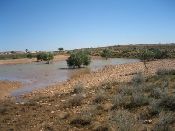|
Modelling offers an alternative and complementary approach to evaluate the likely biophysical effects of adopting different remediation strategies at a regional scale and their financial viability.Two modelling approaches are developed and applied within the DESIRE project to achieve this.
1. Modelling the biophysical impact of soil and water conservation technologies
The biophysical impact of technologies is simulated with an extended version of the PESERA model (Kirkby et al, 2008), originally developed for Pan-European Soil Erosion Assessment within a dedicated EU (FP5) project. As PESERA originally addressed water erosion only, it was extended to capture the processes of grazing, fire and wind erosion as well. The model was also adapted to represent particular management strategies such as mulching, irrigation, terracing, and crop rotations. The model is being adapted to each study area to reflect indicators and land degradation drivers identified as closely as possible. The model can be applied at 100m to 1km resolution scales, with sub-grid routines being used to simulate some of the fine-scale effects. Locally calibrated application of the fine-scale PESERA will then be used to extend the results of pilot area studies to a larger hinterland, in order to evaluate the impact of recommended conservation measures for the surrounding area. PESERA output includes soil erosion, runoff and biomass.
A separate addendum, PESERA-L has been written to simulate situations where shallow landslides specifically are the main land degradation problem.
2. Modelling the financial viability of soil and water conservation technologies
All study sites. The DESMICE (Desertification Mitigation Cost Effectiveness) model is newly developed within the DESIRE project to scale up the financial assessment of mitigation strategies from field to regional scale using a spatially-explicit cost-benefit analysis. Taking the assessments of mitigation strategies selected in stakeholder workshops in each study site as a starting point, DESMICE establishes how investment costs of those strategies change based on environmental conditions and distance to markets or source areas. An example of the importance to consider environmental conditions is the case of terracing: investment cost increases with slope gradient, as terraces need to be more closely spaced on steeper slopes. Distance to markets matters as changing crops or higher yields may mean more produce needs to be transported, implying additional costs. Moreover, some of the technologies themselves require specific inputs. Where e.g. stones are not locally available on the field to construct stone bunds, it may be infeasible to source them from elsewhere. The benefits of soil and water conservation technologies need to be assessed in a similar fashion. DESMICE interacts with PESERA to put a value on the biomass output from the latter. We always need to consider investment options against a without case. DESMICE output can be tailored to stakeholder needs: from a land manager’s perspective, it presents a spatial configuration of where which promising technology is likely to perform well; from a policymakers’ perspective, analyses can be made to see how policies affect the viability of different technologies across a region or where environmental targets can be satisfied at what cost (using cost-effectiveness analysis).
Spain. Using a case study in one site (Guadalentin, Spain), we are also investigating the regional economic effects of adopting different remediation strategies (using input-output modelling), and determining what factors influence the decisions of land managers to adopt different remediation strategies and change land use under different future scenarios (using Agent-Based Modelling). By investigating the effects of different policy scenarios on these decisions, it will be possible to evaluate how different policy options may affect adoption of different remediation strategies and land uses across landscapes, and evaluate the biophysical consequences of such changes.
|


